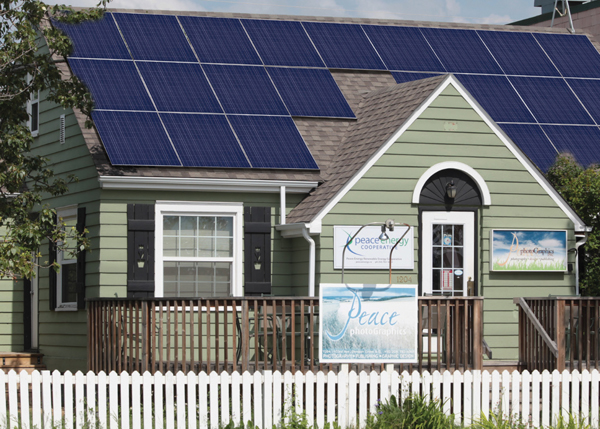Like Ontario, Nova Scotia also has a feed-in tariff directed at community-owned renewable power, the Community Feed-In Tariff (COMFIT), and in fact a separate FIT program for Developmental Tidal Arrays.
To be eligible for COMFIT, the projects must be community-owned and connected at the distribution level (typically under 6 MW). Ministerial approval is required in order to proceed with a project. The program began accepting applications on September 19, 2011, and the first round of project approvals was that December 16. As of April 2013, the following projects had been approved (announcements February 20 and March 26):
• Three 50 kilowatt (kW) small-wind projects owned by the Municipality of the County of Pictou in Riverton
• One 50 kW small-wind project in Melford owned by the Municipality of the District of Guysborough
• One 50 kW small-wind project on Spiddle Hill near Tatamagouche owned by Community Economic Development Investment Fund (CEDIF) Colchester Cumberland Wind Fields
• Two 50 kW small-wind projects in Cheticamp owned by the Port Hood & District Recreation Commission, a local not-for-profit organization
• A 1.8 MW large-wind project owned by Membertou Development Corporation in partnership with Watts Wind Energy (a CEDIF) in Lower Wedgeport
• One 1.9 MW large-wind project in Point Aconi owned by Celtic Current, a CEDIF
• A 4.4 MW large-wind project located in Millbrook owned by Eskasoni First Nation
• One 6.0 MW biomass (combined heat and power) project located in Sydney owned by Cape Breton Explorations
• a 3.2-megawatt wind project owned by Watts Wind Energy, near Porters Lake
• a 100-kilowatt hydro project owned by Halifax Water
• a 50-kilowatt wind project owned by Annapolis Valley Waste in Kentville
• a 500-kilowatt biomass project in Hasset, Digby Co., owned by the Municipality of Digby, using waste from a mink farm
• the Municipality of Shelburne’s 800-kilowatt large wind project in Sandy Point
• two-megawatt wind projects in Yarmouth and Shelburne, owned by Scotian Windfields
• a 1.5-megawatt project in Goldboro, Guysborough Co., and two 50-kilowatt projects in Mulgrave, owned by Celtic Current
• a 50-kilowatt small wind project in Mulgrave owned by the Town of Mulgrave
• a 500-kilowatt biomass project operated by Windmill Hollsteins in Shubenacadie, also using farm waste
• a 1.9-megawatt project operated by Affinity Renewables in Dean, near Stewiacke and 4.8-megawatt project in Truro.
More than 100 locally based proposals were received from more than 20 community groups up to that point under the initiative.
While Nova Scotia is the only province in Canada aside from Ontario with an active community power program, there is some community activity in other provinces as well. (No attempt has been made at comprehensiveness – this brief list is merely indicative):
• The government of New Brunswick announced a Community Energy Policy in 2010, intended to encourage community-based organizations to develop, own and operate renewable electricity generating stations. Under the initiative, 75 megawatts of power in the province’s energy portfolio (25 of that from majority-owned First Nations) are reserved for renewable community energy projects.
With that in mind, the Community Energy Co-op (CEC) in Knowlesville, NB has a number of site studies, in particular a plan for a wind farm of 7 to 10 large wind turbines in Carleton County that would be 51% community owned. However, the price of ten cents / kWh offered for renewable energy under the provincial policy is considered insufficient incentive, so that currently no community organizations have developed projects to the point of seeking contracts.
Incorporated in 2004, CEC also provides services for other organizations, does various kinds of installations and engages in policy discussions. Its office, and several neighbours, are in fact entirely off the grid.
 • Val-Éo is a co-operative formed in 2006 in Québec, with members including 58 farms, close to 100 local individual investors, and two municipalities. In response to a 2010 request for proposals for 500 MW of windpower capacity from Hydro-Québec, it formed a partnership with Algonquin Power, and has received a contract for 24 MW of capacity, with an in-service date of December 1, 2015. The Projet Éolienne Belle-Rivière is located northwest of Chicoutimi, north of the St. Lawrence River.
• Val-Éo is a co-operative formed in 2006 in Québec, with members including 58 farms, close to 100 local individual investors, and two municipalities. In response to a 2010 request for proposals for 500 MW of windpower capacity from Hydro-Québec, it formed a partnership with Algonquin Power, and has received a contract for 24 MW of capacity, with an in-service date of December 1, 2015. The Projet Éolienne Belle-Rivière is located northwest of Chicoutimi, north of the St. Lawrence River.
Val-Éo was assisted in its formation with grants from a couple of provincial agencies, and organizational assistance from the provincial non-profit technology transfer centre Agrinova.
• Saskatoon, Saskatchewan is the home of Community Energy Wind, which at this point is basically an initiative led by one person with twelve years in the wind energy industry, who has been planning a $46 million wind farm that would sell power to the city’s power utility. At this point it remains in the planning stage. But, as founder James Glennie points out, “There is community demand for investment opportunities, and a strong record in community development. Saskatchewan was built on co-operatives. The concept is very well understood here.” (Although they are slowly disappearing, the grain towers with the word POOL on the side in weathered paint were once a distinguishing feature of the Saskatchewan countryside.)
SaskPower has a net metering program, mostly solar, and a small power producers program for those producing surplus power. The province has about 200 MW of commercial-scale wind power capacity installed, with plans to double that by 2017.
 • British Columbia has several co-operatives (Peace Energy co-op in Dawson Creek, the Vancouver Renewable Energy co-op, the Viridian Energy co-op on Vancouver Island, to name three) that provide design, sourcing, installation and consulting services to homeowners and organizations in various parts of the province. BC’s first wind project, Bear Mountain Wind Park, was started by the Peace Energy Co-op.
• British Columbia has several co-operatives (Peace Energy co-op in Dawson Creek, the Vancouver Renewable Energy co-op, the Viridian Energy co-op on Vancouver Island, to name three) that provide design, sourcing, installation and consulting services to homeowners and organizations in various parts of the province. BC’s first wind project, Bear Mountain Wind Park, was started by the Peace Energy Co-op.
Details of Nova Scotia’s COMFIT program
The following technologies are eligible for the program:
• Wind power, 50 kilowatts (kW) or less – 49.9¢ per kWh
• Wind power, over 50 kW – 13.1¢ per kWh
• Small-scale in-stream tidal – 65.2¢ per kWh
• Run-of-the-river hydroelectricity – 14.0¢ per kWh
• Combined heat and power (CHP) biomass – 17.5¢ per kWh
COMFIT Timeline
• April 2010: Community Feed-in Tariff (COMFIT) program introduced in the 2010 Renewable Electricity Plan
• September 19, 2011: Application process opened
• December 16, 2011: First approvals announced
• Winter/Spring 2012: Application processing continues; all approvals announced
• Spring/Fall 2012: Proponents complete any required environmental and technical studies, conduct public consultations and raise capital.
